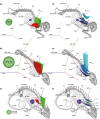Fitting unanchored puzzle pieces in the skeleton: appropriate 3D scapular positions for the quadrupedal support in tetrapods
- PMID: 29322521
- PMCID: PMC5879960
- DOI: 10.1111/joa.12778
Fitting unanchored puzzle pieces in the skeleton: appropriate 3D scapular positions for the quadrupedal support in tetrapods
Abstract
Deducing the scapular positions of extinct tetrapod skeletons remains difficult, because the scapulae and rib cage are connected with each other not directly by skeletal joint, but by thoracic muscles. In extant non-testudine quadrupedal tetrapods, the top positions of the scapulae/suprascapulae occur at the anterior portion of the rib cage, above the vertebral column and near the median plane. The adequacy of this position was tested using three-dimensional mechanical models of Felis, Rattus and Chamaeleo that assumed stances on a forelimb on a single side and the hindlimbs. The net moment about the acetabulum generated by the gravity force and the contractive forces of the anti-gravity thoracic muscles, and the resistance of the rib to vertical compression between the downward gravity and upward lifting force from the anti-gravity thoracic muscle depend on the scapular position. The scapular position common among quadrupeds corresponds to the place at which the roll and yaw moments of the uplifted portion of the body are negligible, where the pitch moment is large enough to lift the body, and above the ribs having high strength against vertical compression. These relationships between scapular position and rib cage morphology should allow reliable reconstruction of limb postures of extinct taxa.
Keywords: limb posture; moment analysis; reconstruction; stress analysis.
© 2018 Anatomical Society.
Figures





Similar articles
-
Relationship between scapular position and structural strength of rib cage in quadruped animals.J Morphol. 2009 Sep;270(9):1084-94. doi: 10.1002/jmor.10744. J Morphol. 2009. PMID: 19378269
-
Elbow joint adductor moment arm as an indicator of forelimb posture in extinct quadrupedal tetrapods.Proc Biol Sci. 2012 Jul 7;279(1738):2561-70. doi: 10.1098/rspb.2012.0190. Epub 2012 Feb 22. Proc Biol Sci. 2012. PMID: 22357261 Free PMC article.
-
Thoracic position effect on shoulder range of motion, strength, and three-dimensional scapular kinematics.Arch Phys Med Rehabil. 1999 Aug;80(8):945-50. doi: 10.1016/s0003-9993(99)90088-6. Arch Phys Med Rehabil. 1999. PMID: 10453773
-
Shoulder muscle activity and function in common shoulder rehabilitation exercises.Sports Med. 2009;39(8):663-85. doi: 10.2165/00007256-200939080-00004. Sports Med. 2009. PMID: 19769415 Review.
-
Three-dimensional scapular orientation and muscle activity at selected positions of humeral elevation.J Orthop Sports Phys Ther. 1996 Aug;24(2):57-65. doi: 10.2519/jospt.1996.24.2.57. J Orthop Sports Phys Ther. 1996. PMID: 8832468 Review.
Cited by
-
Appendicular Muscle Physiology and Biomechanics in Crocodylus niloticus.Integr Org Biol. 2020 Nov 5;2(1):obaa038. doi: 10.1093/iob/obaa038. eCollection 2020. Integr Org Biol. 2020. PMID: 33791576 Free PMC article.
-
Modern three-dimensional digital methods for studying locomotor biomechanics in tetrapods.J Exp Biol. 2023 Apr 25;226(Suppl_1):jeb245132. doi: 10.1242/jeb.245132. Epub 2023 Feb 22. J Exp Biol. 2023. PMID: 36810943 Free PMC article. Review.
-
A three-dimensional musculoskeletal model of the dog.Sci Rep. 2021 May 31;11(1):11335. doi: 10.1038/s41598-021-90058-0. Sci Rep. 2021. PMID: 34059703 Free PMC article.
References
-
- Ahn AN, Furrow E, Biewener AA (2004) Walking and running in the red‐legged running frog, Kassina maculata . J Exp Biol 207, 399–410. - PubMed
-
- Alaverdashvili M, Leblond H, Rossignol S, et al. (2008) Cineradiographic (video X‐ray) analysis of skilled reaching in a single pellet reaching task provides insight into relative contribution of body, head, oral, and forelimb movement in rats. Behav Brain Res 192, 232–247. - PubMed
Publication types
MeSH terms
LinkOut - more resources
Full Text Sources
Other Literature Sources

